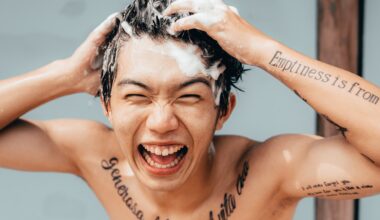Introduction
In the ever-evolving world of haircare, one product has stood the test of time and trends: hair serum. Whether you’re looking to tame frizz, add shine, or protect your hair from environmental stressors, hair serums have become an essential part of many beauty routines. But amidst the sea of options and opinions, a crucial question remains: how much hair serum do you really need, and are there natural alternatives that can achieve the same effects?
In this comprehensive guide, we embark on a journey to demystify the world of hair serums. We’ll explore what makes them a haircare staple, unravel the science behind their efficacy, and delve into the nuances of the right dosage. But we won’t stop there. We’ll also take a detour into the world of natural alternatives, where common kitchen ingredients and age-old remedies can rival the effects of commercial serums.
So, whether you’re a hair serum aficionado or a newcomer to the game, get ready to uncover the secrets of hair serum usage and effect. By the end of this guide, you’ll not only know how to use it for maximum benefit but also have the knowledge to go natural if you choose.
Key Takeaways
In this section, we’ll set the stage by providing key takeaways that readers can expect to gain from the article.
- Hair Serum Basics: What Is It and Why Use It?
- Hair serum is a specialized hair care product designed to address various hair concerns.
- It offers multiple benefits, including taming frizz, adding shine, reducing breakage, and protecting hair from environmental damage.
- Unlike regular conditioners or oils, serums are lightweight and typically contain silicones and other ingredients that coat the hair shaft to create a protective barrier.
- Finding the Balance: The Ideal Amount of Hair Serum
- The right dosage of hair serum is crucial for effective results.
- Using too little may not provide the desired benefits, while using too much can make hair greasy and weigh it down.
- The ideal amount varies based on hair length, type, and individual preferences.
- The Application Technique: Ensuring Even Distribution
- Proper application techniques ensure that the serum is evenly distributed throughout the hair.
- Applying serum to the ends of the hair, rather than the roots, helps prevent greasiness at the scalp.
- Massaging the serum gently into the hair helps it penetrate and work effectively.
- Natural Alternatives to Commercial Hair Serums
- Nature offers a range of ingredients that can replicate the benefits of commercial hair serums.
- Homemade hair serum recipes often include ingredients like aloe vera, coconut oil, argan oil, and essential oils.
- These natural alternatives can provide nourishment, shine, and protection without the use of synthetic chemicals.
- Hair Serum vs. Natural Alternatives: Pros and Cons
- Commercial hair serums offer convenience and often come with advanced formulations for specific hair concerns.
- Natural alternatives are more eco-friendly and may appeal to those looking to minimize chemical exposure.
- The choice between commercial serums and natural alternatives depends on individual preferences and hair care goals.
By understanding these key takeaways, readers will be well-prepared to explore the detailed sections of the article, gaining insights into the world of hair serum usage and discovering natural alternatives for healthier, more beautiful hair.
Decoding Hair Serum: What Is It and Why Use It?
Defining Hair Serum: Its Purpose and Benefits
Hair serum is more than just another product on your bathroom shelf; it’s a specialized elixir designed to address a range of common hair concerns. Unlike traditional oils or conditioners, hair serums are formulated to be lightweight and non-greasy, making them an attractive option for a wide variety of hair types.
Key Benefits of Hair Serum:
- Frizz Control: One of the primary functions of hair serum is taming frizz. It creates a protective barrier that helps prevent moisture from entering the hair shaft, reducing frizz and flyaways.
- Shine Enhancement: Hair serums are renowned for their ability to add a natural shine to your locks. They work by smoothing the hair cuticle, which reflects light more evenly.
- Heat Protection: Many serums contain ingredients that can shield your hair from the damaging effects of heat styling tools like straighteners and curling irons.
- Reduced Breakage: The protective barrier created by hair serum can also help reduce breakage, especially in delicate or damaged hair.
- Environmental Protection: Hair serum can act as a shield against environmental stressors, such as pollution and UV rays, helping to maintain the health and vibrancy of your hair.
The Science Behind Hair Serums
At the heart of hair serum efficacy lie its ingredients, which often include silicones like dimethicone or cyclomethicone. These silicones coat the hair shaft, creating a smooth, protective layer. This layer not only adds shine and reduces frizz but also helps to lock in moisture, preventing hair from becoming too dry.
In essence, hair serum is a versatile and valuable addition to your haircare routine, offering a range of benefits that go beyond what traditional oils or conditioners can achieve.
Quantity Matters: How to Determine the Right Amount of Serum
The ‘Less Is More’ Approach: Avoiding Serum Overload
While the benefits of hair serum are undeniable, it’s crucial to follow the golden rule of application: less is more. Using too much serum can lead to undesirable consequences, such as greasiness and weighed-down hair. Here’s how to strike the right balance:
Guidelines Based on Hair Length and Type
- Short Hair: For short hair, a pea-sized amount of serum should suffice. Start with a small quantity and adjust as needed. Remember, you can always add more if necessary.
- Medium-Length Hair: If your hair falls into the medium-length category, begin with a thumbnail-sized amount. This should provide adequate coverage without overloading your hair.
- Long Hair: Long hair may require a bit more serum, but don’t go overboard. Start with a thumbnail-sized amount and assess how your hair feels. You can gradually increase the quantity if your hair seems to absorb it well.
- Curly or Coarse Hair: These hair types often benefit from additional moisture. Start with a slightly larger quantity, such as two thumbnail-sized amounts, and adjust based on your hair’s response.
- Fine Hair: Fine hair can be more susceptible to becoming greasy with excess serum. Begin with a smaller amount, like half a thumbnail-sized portion, and assess whether your hair needs more.
Signs You’re Using Too Much or Too Little
Recognizing the signs of improper serum usage is key to achieving the right balance:
Using Too Much Serum:
- Greasy Appearance: If your hair looks excessively greasy or oily even after thorough application, you’ve likely used too much serum.
- Heaviness: Hair serum should enhance your hair’s natural movement, not weigh it down. If your hair feels heavy and limp, you’ve gone overboard.
- Attracts Dirt: Overly greasy hair can attract dust and dirt, leaving your hair looking dull and requiring more frequent washing.
Using Too Little Serum:
- Lackluster Hair: If your hair doesn’t appear shinier or smoother after applying serum, you might not be using enough.
- Dryness: Hair serum is also meant to provide moisture. If your hair feels dry or brittle even after application, consider using a slightly larger quantity.
- Missed Benefits: Underusing serum means your hair isn’t reaping the full benefits of the nutrients and protection it offers.
Remember, the right amount of serum can vary from person to person, so it’s essential to pay attention to your hair’s needs and adjust your usage accordingly. With practice, you’ll find the perfect balance for your hair’s health and appearance.
The Application Technique: Ensuring Even Distribution
Proper Application Techniques for Hair Serum
The effectiveness of hair serum isn’t solely determined by the product itself; how you apply it matters just as much. Follow these steps to ensure even distribution and maximize the benefits of your hair serum:
Step 1: Start with Clean, Damp Hair Before applying hair serum, make sure your hair is clean and slightly damp. You can achieve this by either towel-drying your hair after a shower or using a spray bottle to dampen it. Avoid applying serum to completely dry hair, as it may not distribute evenly.
Step 2: Determine the Right Amount Refer to the guidelines based on your hair length and type mentioned earlier in this article. Dispense the appropriate amount of serum into your palm. Remember, it’s easier to add more if needed than to deal with excess serum in your hair.
Step 3: Emulsify the Serum Rub the serum between your palms to warm it up and spread it evenly. This step is essential to ensure that the serum is applied uniformly throughout your hair.
Step 4: Section Your Hair Divide your hair into sections to make sure you cover every strand. This is especially important if you have thick or long hair. Use clips or hairbands to keep the sections separate.
Step 5: Apply to the Ends First Start by applying the serum to the ends of your hair. These areas are usually drier and more prone to damage. Work your way up to the mid-lengths and, if necessary, lightly apply any remaining serum to the upper portion of your hair. Avoid applying serum to the roots, as this can make your hair look greasy.
Step 6: Massage Gently Using your fingertips, gently massage the serum into your hair. This not only helps with even distribution but also stimulates blood flow to the scalp, which can promote hair health.
Step 7: Comb Through For additional evenness, comb your hair with a wide-toothed comb after applying the serum. This helps ensure that every strand is coated and detangles your hair in the process.
Step 8: Style as Desired You can now proceed with your regular styling routine. Whether you air-dry your hair or use heat styling tools, the serum will provide a protective barrier.
Step 9: Assess and Adjust After styling, assess your hair’s appearance and texture. If you feel that your hair requires more serum for added shine or smoothness, you can apply a tiny amount to specific areas.
By following these steps, you’ll ensure that the serum is evenly distributed, maximizing its benefits while avoiding greasiness or heaviness.
Natural Alternatives to Commercial Hair Serums
Exploring Nature’s Solutions: Homemade Hair Serum Recipes
If you prefer a more natural approach to haircare, you’ll be delighted to know that many common kitchen ingredients and age-old remedies can replicate the benefits of commercial hair serums. Let’s delve into some homemade hair serum recipes:
1. Aloe Vera Serum:
- Ingredients: Aloe vera gel, coconut oil, vitamin E oil.
- Method: Mix equal parts aloe vera gel and coconut oil, then add a few drops of vitamin E oil. Blend well and apply sparingly to damp hair.
- Benefits: Aloe vera hydrates, coconut oil adds shine, and vitamin E oil nourishes your locks.
2. Argan Oil Elixir:
- Ingredients: Argan oil, lavender essential oil, rosemary essential oil.
- Method: Combine argan oil with a few drops of lavender and rosemary essential oils. Apply a small amount to damp hair.
- Benefits: Argan oil is rich in nutrients, while lavender and rosemary oils promote hair health.
3. Honey and Olive Oil Blend:
- Ingredients: Honey, olive oil.
- Method: Mix honey with an equal amount of olive oil. Apply sparingly to damp hair.
- Benefits: Honey adds shine and softness, and olive oil provides deep nourishment.
4. Avocado and Banana Nourisher:
- Ingredients: Ripe avocado, ripe banana, olive oil.
- Method: Blend a ripe avocado and banana with a tablespoon of olive oil. Apply the mixture to damp hair.
- Benefits: Avocado and banana are packed with nutrients that promote hair strength and shine.
5. Egg White Serum:
- Ingredients: Egg white, lemon juice, honey.
- Method: Whisk an egg white and add a teaspoon each of lemon juice and honey. Apply sparingly to damp hair.
- Benefits: Egg whites provide protein, lemon juice adds shine, and honey moisturizes.
Benefits and Limitations of Natural Alternatives
Natural alternatives offer several advantages:
- Eco-Friendly: They often have a smaller environmental footprint compared to commercial products.
- Minimal Chemical Exposure: They reduce exposure to synthetic chemicals.
- Customization: You have the flexibility to tailor recipes to your specific hair needs.
However, it’s essential to recognize that natural alternatives may have limitations, such as shorter shelf lives and a need for more frequent application. Experimentation is key to finding the recipe that works best for your hair type and concerns.
Hair Serum vs. Natural Alternatives: Pros and Cons
Weighing Your Options: Commercial Hair Serums vs. Natural Alternatives
As you embark on your hair care journey, you’ll likely find yourself at a crossroads, deciding between commercial hair serums and natural alternatives. Each option comes with its own set of advantages and considerations. Let’s explore the pros and cons of both:
Commercial Hair Serums:
Pros:
- Advanced Formulations: Commercial serums often feature advanced formulations tailored to specific hair concerns, such as frizz control, heat protection, or color preservation.
- Convenience: They are readily available and convenient to use, requiring minimal preparation.
- Long Shelf Life: Commercial serums typically have longer shelf lives and do not require refrigeration.
Cons:
- Chemical Ingredients: They may contain synthetic chemicals, which can be a concern for those looking to minimize chemical exposure.
- Environmental Impact: The production and packaging of commercial products can have a larger environmental footprint.
Natural Alternatives:
Pros:
- Eco-Friendly: Homemade alternatives are often more eco-friendly, as they use fewer resources and generate less waste.
- Customization: You have the freedom to tailor natural recipes to your unique hair needs and preferences.
- Minimal Chemical Exposure: Using natural ingredients reduces exposure to synthetic chemicals.
Cons:
- Shorter Shelf Life: Homemade alternatives generally have shorter shelf lives and may require refrigeration.
- Preparation Time: They require preparation before application, which may not be as convenient as commercial products.
- Variable Efficacy: The effectiveness of natural alternatives can vary based on individual hair type and the specific recipe used.
Making an Informed Choice
The choice between commercial hair serums and natural alternatives ultimately depends on your priorities, preferences, and hair care goals. Consider factors such as the specific needs of your hair, your commitment to minimizing chemical exposure, and your willingness to invest time in preparation. Some individuals even opt for a combination of both, using commercial serums for specific concerns and natural alternatives for routine maintenance.
Regardless of your choice, the key is to prioritize the health and well-being of your hair. With awareness and experimentation, you can discover the regimen that best suits your needs and helps you achieve the hair you desire.
Recommendations: Choosing the Right Path for Your Hair
Personalized Hair Care: Tailoring Your Approach
When it comes to hair care, one size does not fit all. Your hair is as unique as you are, and the path you choose should reflect your individual needs and preferences. Here are some recommendations to help you make informed decisions:
- Assess Your Hair Type and Concerns:
- Begin by understanding your hair type (straight, curly, wavy) and specific concerns (frizz, dryness, breakage).
- Knowing your hair’s characteristics will guide your choice between commercial serums and natural alternatives.
- Prioritize Health:
- Regardless of your choice, prioritize the health of your hair. Look for products or recipes that offer nourishing benefits.
- Avoid overloading your hair with products, as this can lead to buildup and other issues.
- Experiment and Adapt:
- Don’t be afraid to experiment. It may take some trial and error to find the perfect serum or recipe for your hair.
- Be open to adjusting your routine based on your hair’s response and changing seasons.
- Balance Convenience and Natural:
- If you value convenience, consider using commercial serums for specific needs like heat protection.
- For a more natural approach, explore homemade alternatives for regular maintenance.
- Sustainability Matters:
- If environmental sustainability is important to you, lean toward natural alternatives with minimal packaging.
- Look for brands that prioritize eco-friendly practices in their commercial serums.
- Stay Informed:
- Keep up with the latest developments in hair care and product formulations.
- Stay informed about the ingredients in both commercial and natural products to make conscious choices.
- Listen to Your Hair:
- Your hair often communicates its needs. Pay attention to how it responds to different products and adjust accordingly.
Remember, the goal is to have healthy, vibrant hair that makes you feel confident and beautiful. Whether you choose commercial serums, natural alternatives, or a combination of both, your hair care journey should be a rewarding and enjoyable experience.
Conclusion
In the world of hair care, where countless products promise miracles, one thing remains constant: the desire for beautiful, healthy hair. Through our exploration of “Hair Serum Usage and Effect: How Much Hair Serum Do I Need and Natural Alternatives,” we’ve unveiled the secrets to achieving that coveted hair perfection.
From understanding the fundamentals of hair serum to determining the right dosage for your hair type and delving into the world of natural alternatives, you’ve been equipped with knowledge to make informed choices. Whether you opt for the convenience of commercial serums or the allure of homemade elixirs, your hair care journey is uniquely yours.
But amidst the myriad options and considerations, one truth prevails: healthy hair is the result of thoughtful care, nourishment, and attention. Listen to your hair’s needs, adapt your routine, and celebrate the beauty that is uniquely yours.
As you embark on this journey, may you embrace the power to choose what’s best for your hair, your well-being, and the planet. Whether you opt for the science of serums or the charm of natural ingredients, may your hair shine with health and radiate the confidence that comes from knowing you’ve made choices that matter.






